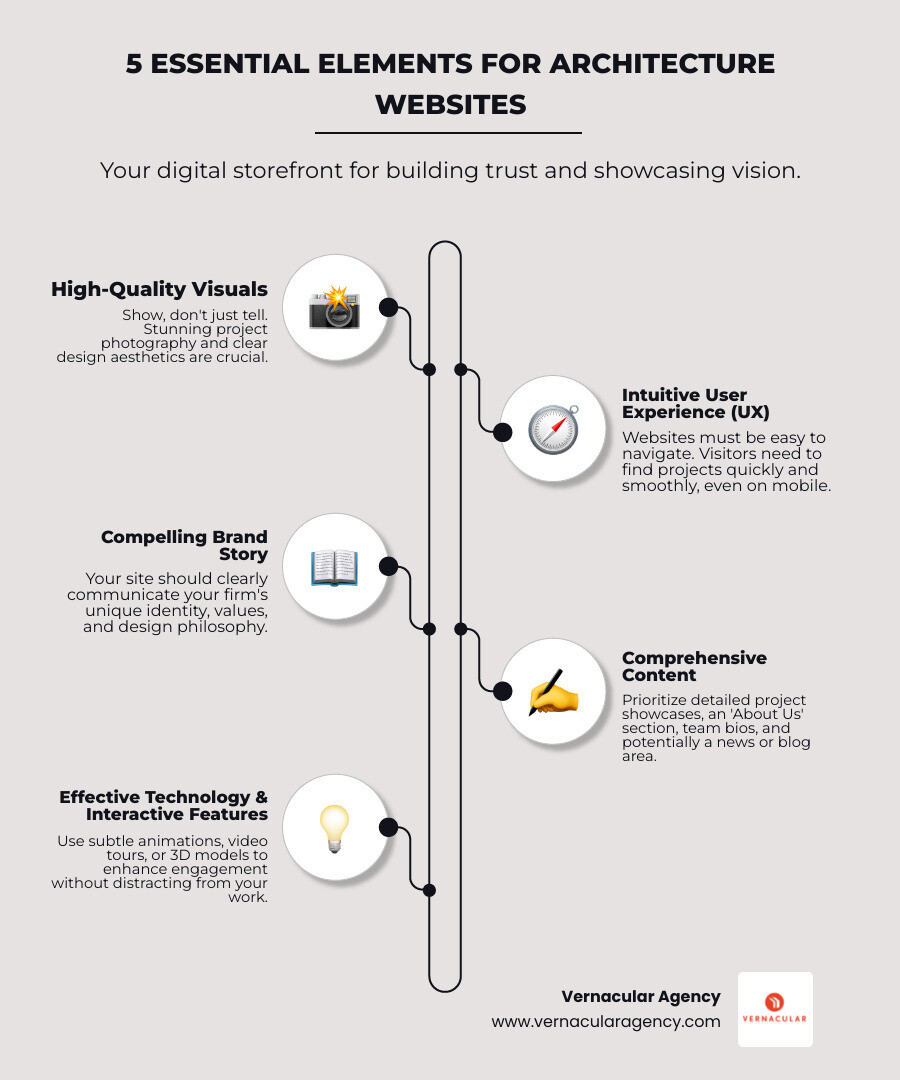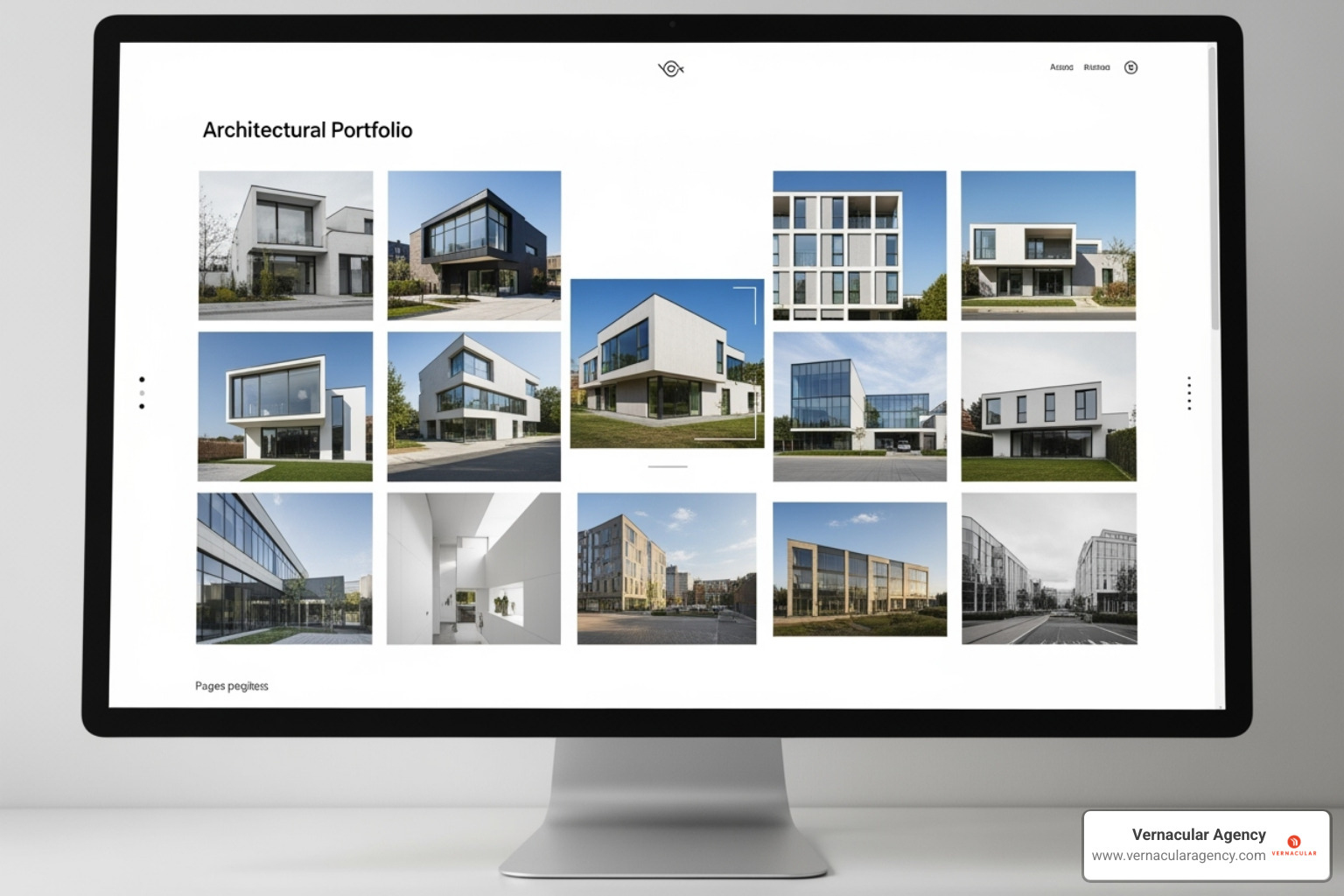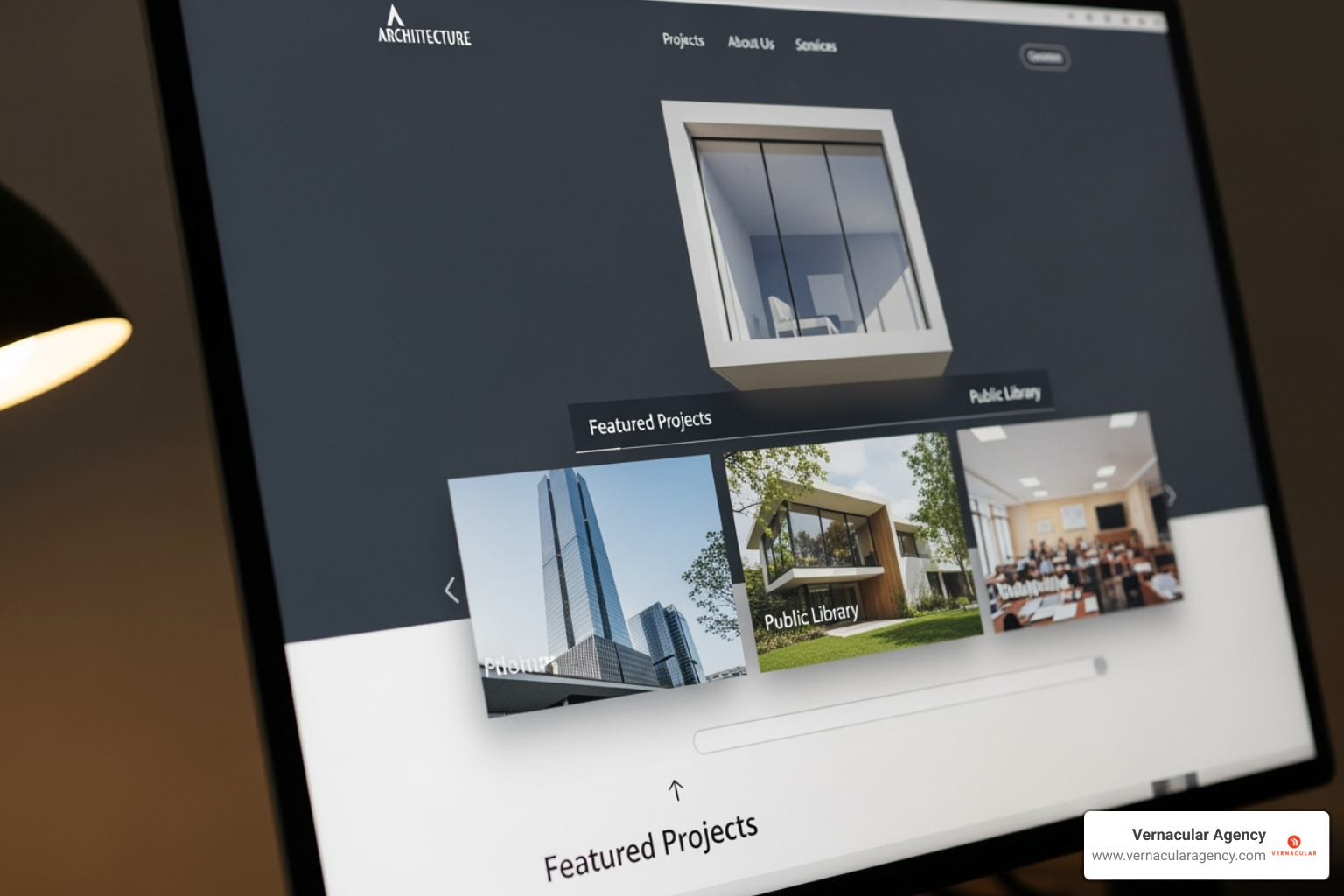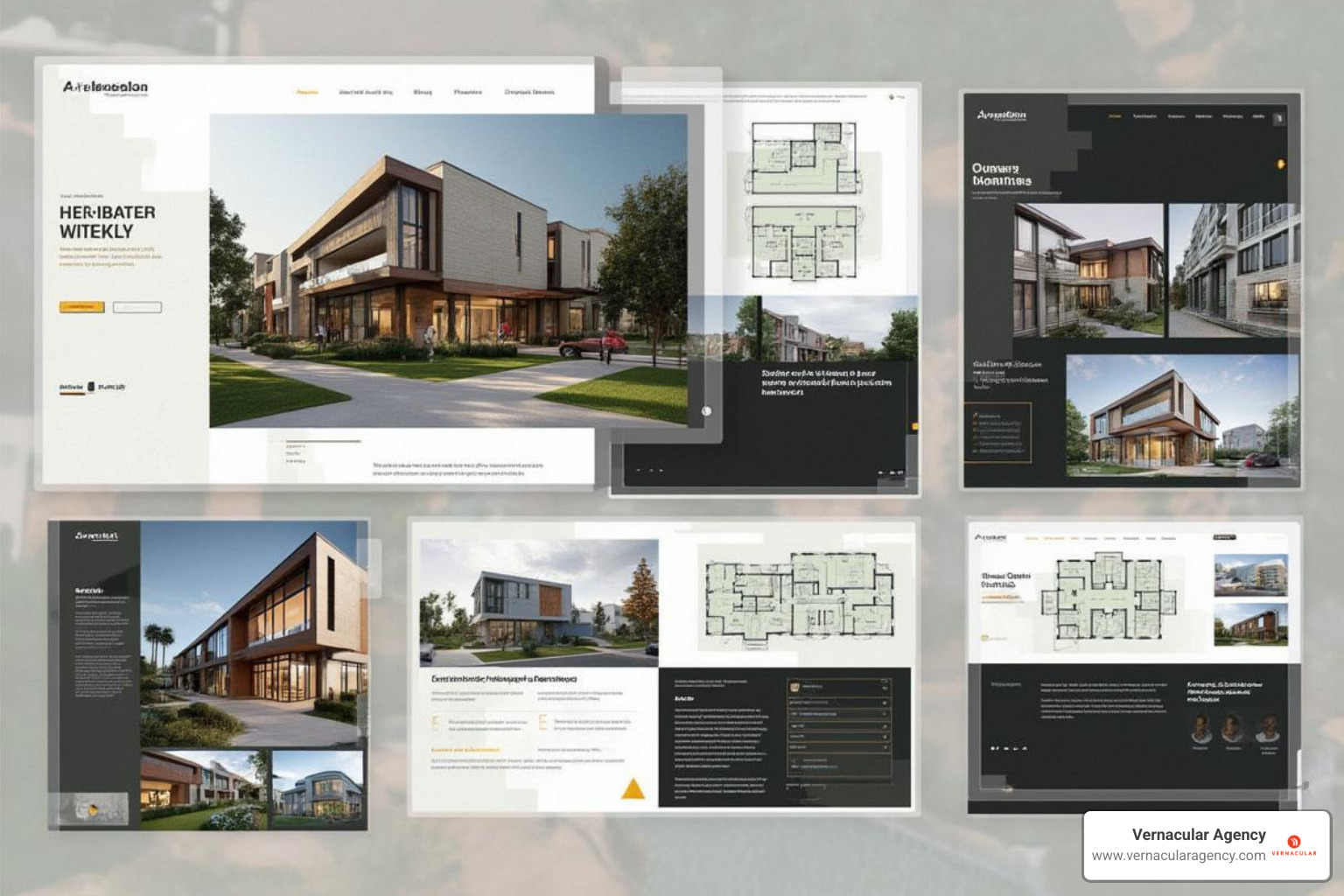When it comes to building trust and attracting clients, architecture firm websites are your most powerful tool. They act as your digital front door. A great site can win over prospects before you even meet them.
Here are the 5 core elements that make a successful architecture firm website:
Your website isn't just a portfolio; it's a strategic asset. It tells your story and showcases your vision.
As Creative Director, Rebecca Falzano guides content and design, with nearly 15 years of experience bringing stories to life for shelter magazines. Her expertise in visual storytelling and effective communication is key to crafting compelling architecture firm websites that resonate with clients. This article will explore the best examples and key strategies for building a powerful online presence.

Architecture firm websites glossary:
Before diving into aesthetics, it's crucial to define your strategy. Your architecture firm website is more than a digital gallery; it's a powerful business tool with specific goals.
First, your website must attract your ideal clients. It should clearly showcase your expertise and communicate your unique philosophy. For instance, Feldman Architecture's site immediately conveys their dedication to sustainability and collaboration, attracting clients who share those values. Similarly, Clayton Korte's site expresses a holistic design philosophy, aiming to "celebrate their environment and exalt the human experience." Your site helps potential clients understand who you are and how you think about design.
Beyond attracting clients, your website is vital for building credibility and establishing a strong brand identity. It’s your chance to differentiate from competitors. The Ranch Mine, for example, positions itself as designing "Homes for modern pioneers," appealing to "trailblazers." This niche language sets them apart. Olson Kundig showcases a sophisticated approach by balancing "rational and intuitive thinking." The design and build of your website directly project the quality and style of your firm's work, making a powerful statement about how you operate.
These efforts lead to one critical goal: generating qualified leads. Your website must compel visitors to take the next step. By demonstrating your capabilities, values, and track record, you build the confidence needed for potential clients to reach out. The objective is to make your firm's value easy to understand and impossible to ignore, turning casual browsers into engaged prospects.
Ready to dive deeper into how your website can become a strategic asset? Explore our insights on Digital Marketing for Architecture Firms to learn more about attracting the right clientele online.

The best architecture firm websites are more than online portfolios; they are immersive experiences. Many award-winning sites, recognized by authorities like Awwwards, demonstrate what's possible with innovative design and functionality. Let's explore some high-performing site archetypes and the lessons they offer.
Minimalist design focuses on what matters: your work. These sites use high-quality imagery, sophisticated typography, and generous white space to let each project breathe. Navigation is intuitive and streamlined, allowing visitors to quickly grasp your firm's capabilities without distraction. For example, Minale + Mann's site uses a minimalist design with visual navigation and complex animations. This clean approach projects confidence and precision. Similarly, Ayers Saint Gross won an award for "Best User Experience" with a site that proves simplicity can be incredibly powerful.
To showcase your process, an interactive storytelling approach is highly effective. These architecture firm websites use engaging animations, video backgrounds, or interactive maps to guide users through a narrative, immersing them in your design journey.

Archipelago's website stands out with its unique design, interactive elements, and hover effects. Delcon also improves user experience with subtle animation and video. The key is that interactive features must improve usability, not hinder it. Avoid elements that are "constantly moving" or make the site "hard to steer."
For more on crafting engaging online spaces, our insights on Website Design for Architects offer further guidance.
Your website is an extension of your firm's identity. Brand-driven sites use a unique visual language—bold colors, custom iconography—to reflect the firm's culture and values. Feldman Architecture is a great example, with a site focused on collaboration and sustainability that mirrors their philosophy of creating spaces that "sit gracefully and lightly on the earth." This commitment is reinforced through publications like their monograph on their work. The Ranch Mine's "Homes for modern pioneers" tagline projects a specific ethos, while Anotherkind Architects uses a "bright and playful brand" to stand out. These sites articulate a unique point of view to attract like-minded clients.
For firms prioritizing thought leadership, a content-rich website is essential. These sites feature detailed case studies, process explanations, team biographies, and a news or articles section. The goal is to build trust by showcasing expertise. Feldman Architecture's site, with its numerous projects and news articles, is a prime example. MVRDV's homepage showcases the breadth of their capabilities, serving as a comprehensive digital portfolio. BIG provides extensive project details, including collaborators and awards, positioning them as authorities. The Ranch Mine integrates client testimonials and press features to build credibility. This rich content turns a website into a valuable resource.
To ensure your content attracts the right audience, understanding SEO Strategies for Architects is key.
Now let's get practical. This section covers the must-have features that make an architecture firm website functional and effective, guiding a potential client from browsing to outreach.
User experience (UX) is paramount. A slow, clunky, or confusing site, especially on mobile, will drive potential clients away. A great UX includes:
Content tells your story, showcases your talent, and builds rapport. Key elements include:
The Ranch Mine effectively weaves in client testimonials and press features, turning visitors into interested leads.

Technology can help your architecture firm website stand out, but it must serve a purpose. The goal is to improve the user experience, not distract from it.
Interactive elements should improve, not distract. Features like hover effects or dynamic filters can make a portfolio more engaging, but avoid "constantly moving interfaces" or "auto-play sound," which can hinder usability. Every feature should improve storytelling or boost usability. For more ideas, check out our insights on Architecture and Design Websites.
A poorly constructed website can undermine even the most stunning architectural designs. Your architecture firm website must avoid certain pitfalls to ensure it helps, not hinders, your firm's growth. Simple mistakes can turn potential clients away instantly.
Frustrating roadblocks on your website can cost you business. Here are common mistakes to avoid:
Avoiding these pitfalls is as crucial as implementing best practices. A well-designed site, free of these digital tripwires, conveys the professionalism clients expect.
Your architecture firm website is a significant investment that should deliver a clear return. To understand its value and ensure it's driving growth, you must measure its impact. Tracking performance allows you to see what's working, identify areas for improvement, and optimize your strategy.
To determine if your website is effective, monitor these key metrics:
Regularly reviewing these metrics enables you to make informed decisions to improve your architecture firm website, ensuring it remains a powerful engine for your practice's growth. For comprehensive support, explore our SEO & Website Optimization Management services.
For your architecture firm website, prioritize quality over quantity. A strong foundation includes a portfolio of your best 10-15 projects with high-quality images and concise descriptions, a compelling "About" page detailing your firm's philosophy and team, and a clear "Contact" page. Additional content like blog posts can boost SEO and establish thought leadership, but it should be strategic. For example, a firm like Feldman Architecture uses a comprehensive content strategy with many projects and articles, but it's built on a foundation of quality.
It is absolutely critical. A significant number of potential clients and collaborators will view your site on a mobile device. If your architecture firm website is slow, clunky, or hard to steer on a small screen, visitors will leave. A poor mobile experience reflects negatively on your firm's attention to detail. Your website must be fast and responsive across all devices to provide a seamless user experience and meet your audience where they are.
Yes, a blog or news section is highly beneficial. It's a fantastic tool for SEO, allowing you to target keywords potential clients are searching for. Beyond SEO, it establishes your firm as a thought leader by providing a space to share firm updates, discuss design trends, and offer valuable insights. It signals that your firm is active and engaged in the industry, like the news sections on the sites of firms like Feldman Architecture or Olson Kundig.
The key takeaway is that your architecture firm website is far more than a digital brochure. It is a masterful creation blending stunning visuals, intuitive functionality, and compelling brand storytelling that resonates with your ideal clients.
Your website is your firm's digital front door, open 24/7. It's the first impression that builds trust, communicates your vision, and attracts the right clients before the first conversation begins. By focusing on user experience and clearly articulating what makes your firm unique, your website becomes a powerful engine for growth.
At Vernacular Agency, we specialize in crafting these impactful digital experiences. We understand that your website must reflect the same precision, creativity, and quality that you bring to every architectural project.
If you're ready to build a website that truly represents your firm's excellence, we can help. Explore our Web Development Services and let's start building your most important marketing tool.